Analysing Leadership and Management Styles in Organisations: 3M UK
VerifiedAdded on 2024/06/12
|18
|5318
|214
Essay
AI Summary
This essay provides a comprehensive analysis of leadership and management within organizations, contrasting the core concepts of each. It explores various leadership theories, including transformational leadership, and management styles, such as democratic management, highlighting their respective advantages and disadvantages. The essay uses 3M UK, a science-based technology company, as a case study to illustrate how transformational leadership and a democratic management style can enhance employee productivity and organizational success. It further delves into the characteristics of transformational leadership, emphasizing its ability to inspire, motivate, and articulate a clear vision, while also acknowledging its potential challenges in detail-oriented tasks. The essay concludes by reinforcing the interconnectedness of leadership and management as vital components for organizational growth.
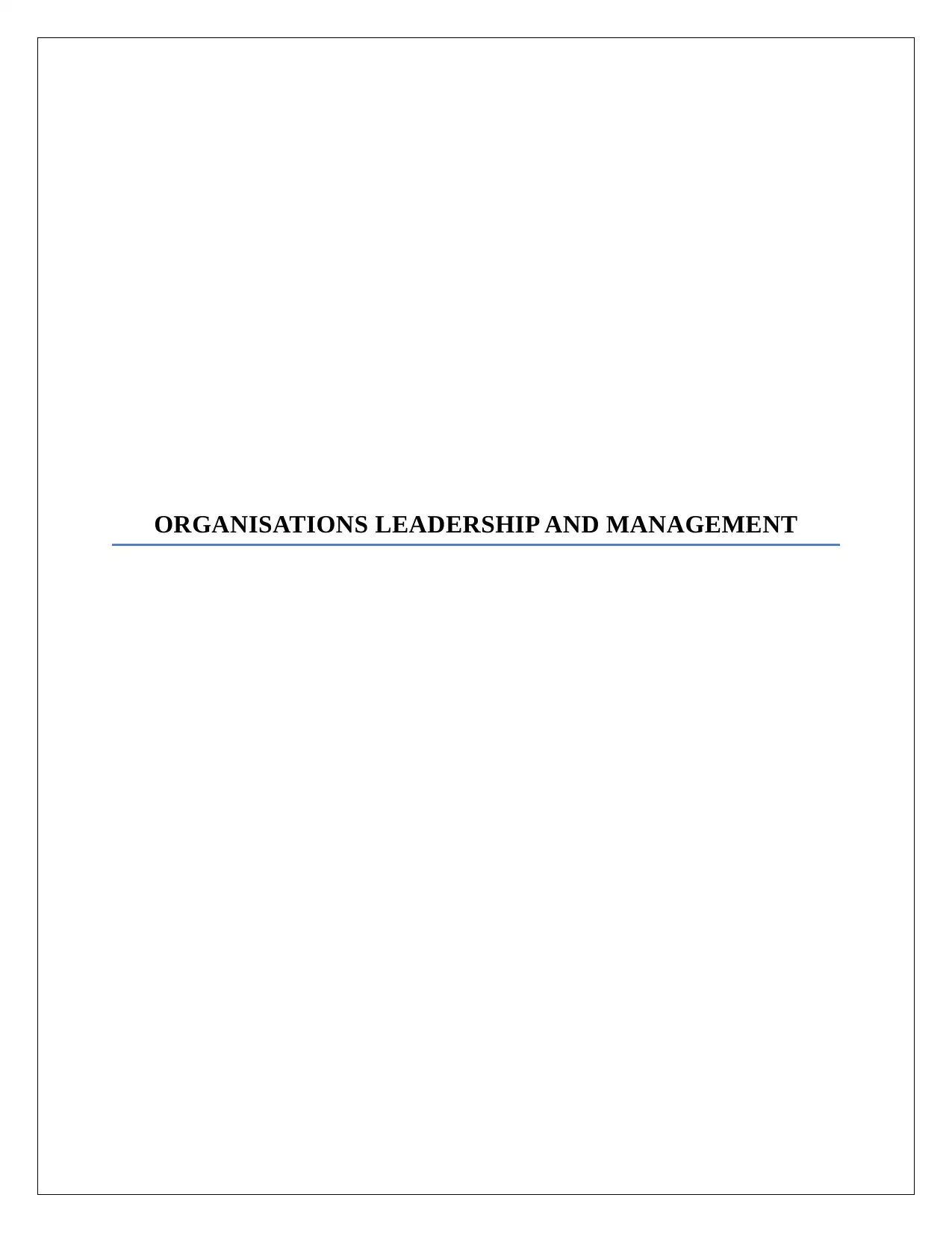
ORGANISATIONS LEADERSHIP AND MANAGEMENT
Paraphrase This Document
Need a fresh take? Get an instant paraphrase of this document with our AI Paraphraser
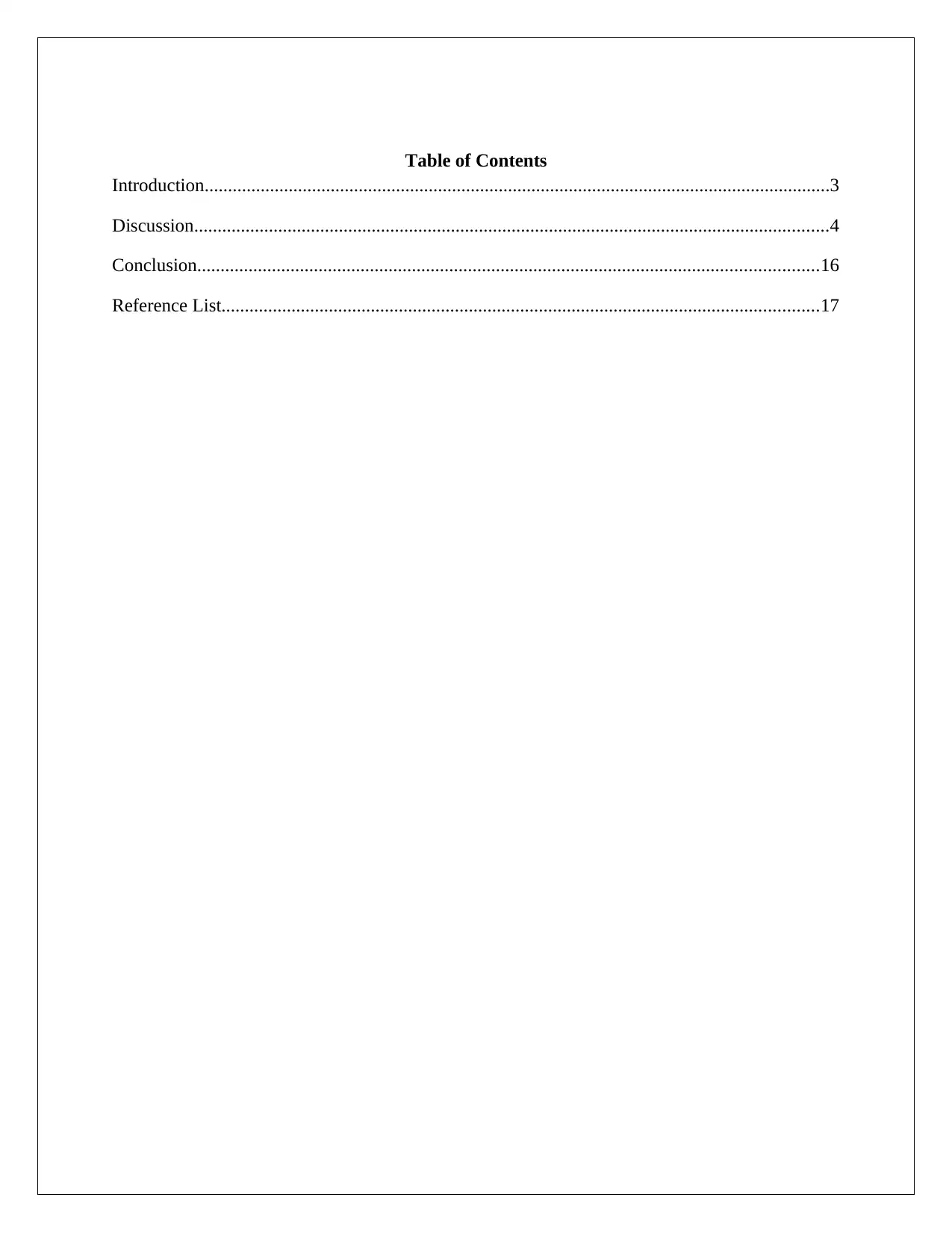
Table of Contents
Introduction......................................................................................................................................3
Discussion........................................................................................................................................4
Conclusion.....................................................................................................................................16
Reference List................................................................................................................................17
Introduction......................................................................................................................................3
Discussion........................................................................................................................................4
Conclusion.....................................................................................................................................16
Reference List................................................................................................................................17
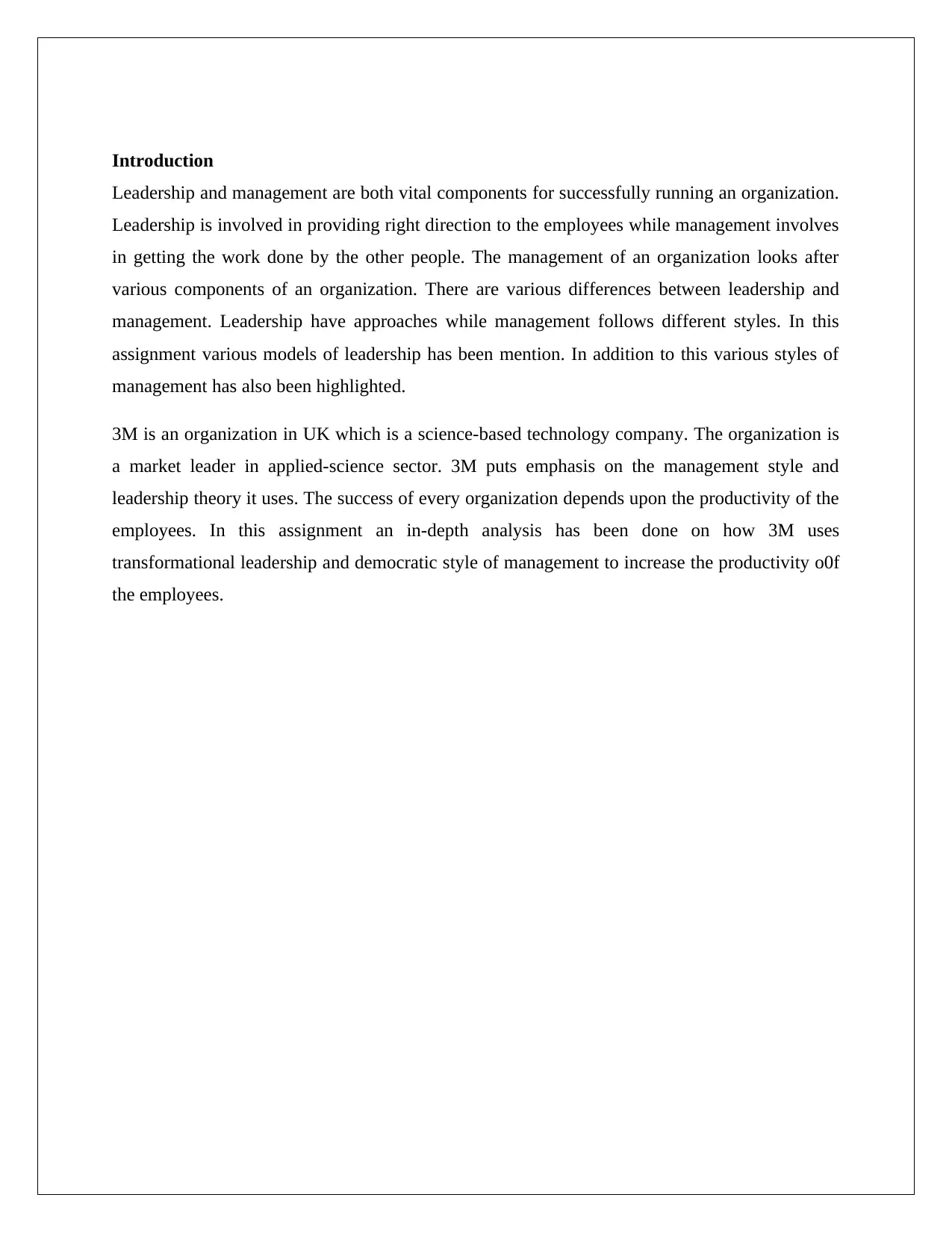
Introduction
Leadership and management are both vital components for successfully running an organization.
Leadership is involved in providing right direction to the employees while management involves
in getting the work done by the other people. The management of an organization looks after
various components of an organization. There are various differences between leadership and
management. Leadership have approaches while management follows different styles. In this
assignment various models of leadership has been mention. In addition to this various styles of
management has also been highlighted.
3M is an organization in UK which is a science-based technology company. The organization is
a market leader in applied-science sector. 3M puts emphasis on the management style and
leadership theory it uses. The success of every organization depends upon the productivity of the
employees. In this assignment an in-depth analysis has been done on how 3M uses
transformational leadership and democratic style of management to increase the productivity o0f
the employees.
Leadership and management are both vital components for successfully running an organization.
Leadership is involved in providing right direction to the employees while management involves
in getting the work done by the other people. The management of an organization looks after
various components of an organization. There are various differences between leadership and
management. Leadership have approaches while management follows different styles. In this
assignment various models of leadership has been mention. In addition to this various styles of
management has also been highlighted.
3M is an organization in UK which is a science-based technology company. The organization is
a market leader in applied-science sector. 3M puts emphasis on the management style and
leadership theory it uses. The success of every organization depends upon the productivity of the
employees. In this assignment an in-depth analysis has been done on how 3M uses
transformational leadership and democratic style of management to increase the productivity o0f
the employees.
⊘ This is a preview!⊘
Do you want full access?
Subscribe today to unlock all pages.

Trusted by 1+ million students worldwide
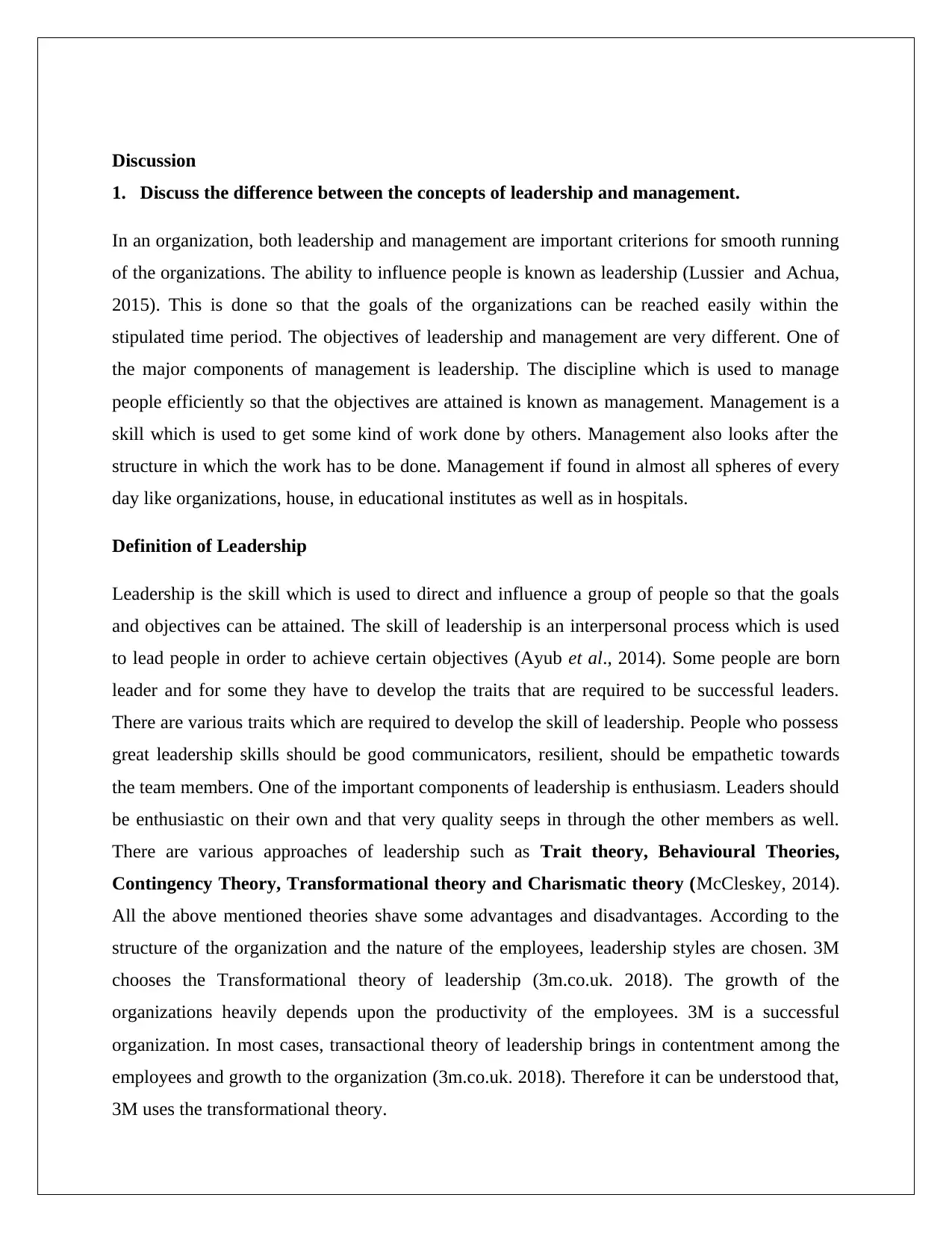
Discussion
1. Discuss the difference between the concepts of leadership and management.
In an organization, both leadership and management are important criterions for smooth running
of the organizations. The ability to influence people is known as leadership (Lussier and Achua,
2015). This is done so that the goals of the organizations can be reached easily within the
stipulated time period. The objectives of leadership and management are very different. One of
the major components of management is leadership. The discipline which is used to manage
people efficiently so that the objectives are attained is known as management. Management is a
skill which is used to get some kind of work done by others. Management also looks after the
structure in which the work has to be done. Management if found in almost all spheres of every
day like organizations, house, in educational institutes as well as in hospitals.
Definition of Leadership
Leadership is the skill which is used to direct and influence a group of people so that the goals
and objectives can be attained. The skill of leadership is an interpersonal process which is used
to lead people in order to achieve certain objectives (Ayub et al., 2014). Some people are born
leader and for some they have to develop the traits that are required to be successful leaders.
There are various traits which are required to develop the skill of leadership. People who possess
great leadership skills should be good communicators, resilient, should be empathetic towards
the team members. One of the important components of leadership is enthusiasm. Leaders should
be enthusiastic on their own and that very quality seeps in through the other members as well.
There are various approaches of leadership such as Trait theory, Behavioural Theories,
Contingency Theory, Transformational theory and Charismatic theory (McCleskey, 2014).
All the above mentioned theories shave some advantages and disadvantages. According to the
structure of the organization and the nature of the employees, leadership styles are chosen. 3M
chooses the Transformational theory of leadership (3m.co.uk. 2018). The growth of the
organizations heavily depends upon the productivity of the employees. 3M is a successful
organization. In most cases, transactional theory of leadership brings in contentment among the
employees and growth to the organization (3m.co.uk. 2018). Therefore it can be understood that,
3M uses the transformational theory.
1. Discuss the difference between the concepts of leadership and management.
In an organization, both leadership and management are important criterions for smooth running
of the organizations. The ability to influence people is known as leadership (Lussier and Achua,
2015). This is done so that the goals of the organizations can be reached easily within the
stipulated time period. The objectives of leadership and management are very different. One of
the major components of management is leadership. The discipline which is used to manage
people efficiently so that the objectives are attained is known as management. Management is a
skill which is used to get some kind of work done by others. Management also looks after the
structure in which the work has to be done. Management if found in almost all spheres of every
day like organizations, house, in educational institutes as well as in hospitals.
Definition of Leadership
Leadership is the skill which is used to direct and influence a group of people so that the goals
and objectives can be attained. The skill of leadership is an interpersonal process which is used
to lead people in order to achieve certain objectives (Ayub et al., 2014). Some people are born
leader and for some they have to develop the traits that are required to be successful leaders.
There are various traits which are required to develop the skill of leadership. People who possess
great leadership skills should be good communicators, resilient, should be empathetic towards
the team members. One of the important components of leadership is enthusiasm. Leaders should
be enthusiastic on their own and that very quality seeps in through the other members as well.
There are various approaches of leadership such as Trait theory, Behavioural Theories,
Contingency Theory, Transformational theory and Charismatic theory (McCleskey, 2014).
All the above mentioned theories shave some advantages and disadvantages. According to the
structure of the organization and the nature of the employees, leadership styles are chosen. 3M
chooses the Transformational theory of leadership (3m.co.uk. 2018). The growth of the
organizations heavily depends upon the productivity of the employees. 3M is a successful
organization. In most cases, transactional theory of leadership brings in contentment among the
employees and growth to the organization (3m.co.uk. 2018). Therefore it can be understood that,
3M uses the transformational theory.
Paraphrase This Document
Need a fresh take? Get an instant paraphrase of this document with our AI Paraphraser
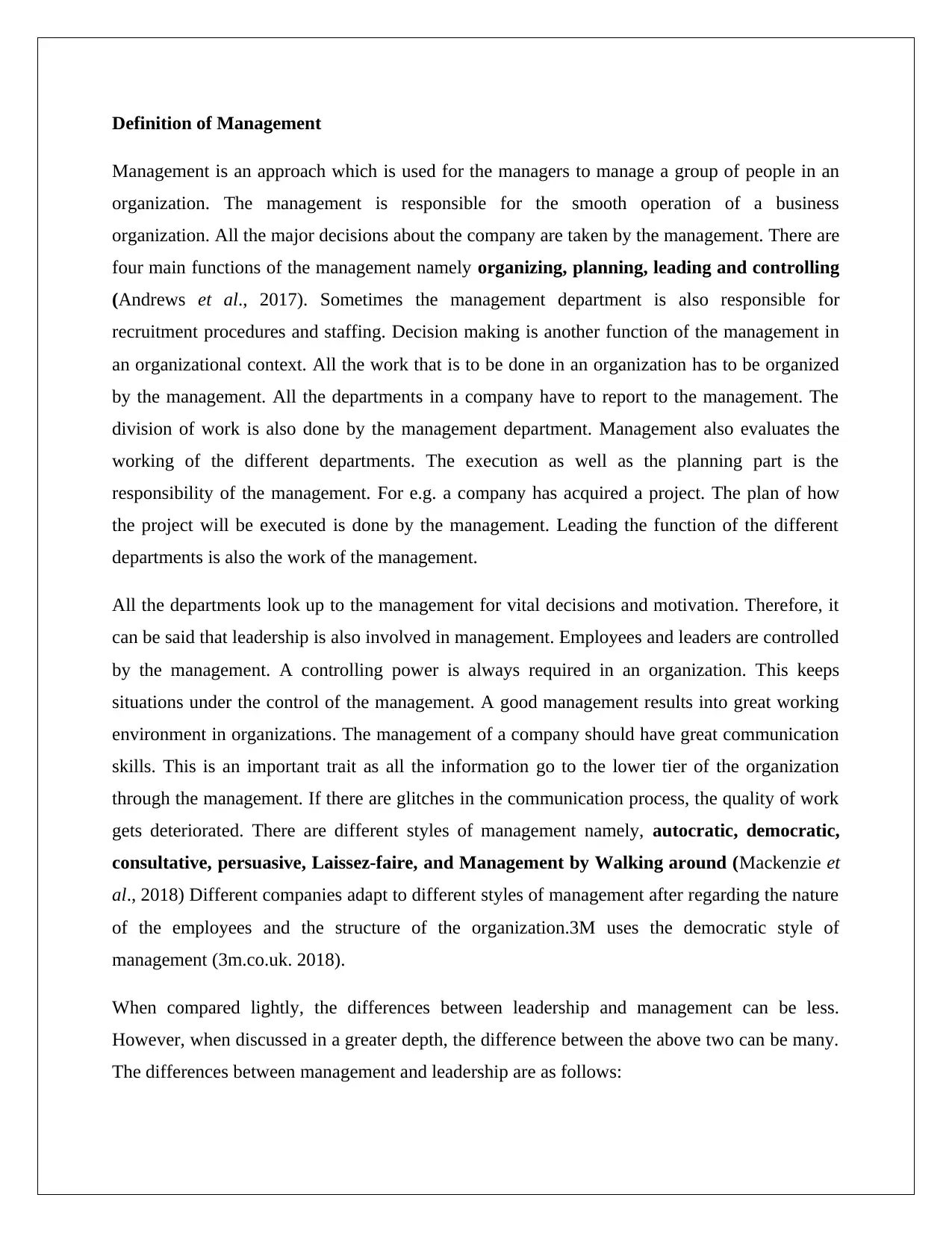
Definition of Management
Management is an approach which is used for the managers to manage a group of people in an
organization. The management is responsible for the smooth operation of a business
organization. All the major decisions about the company are taken by the management. There are
four main functions of the management namely organizing, planning, leading and controlling
(Andrews et al., 2017). Sometimes the management department is also responsible for
recruitment procedures and staffing. Decision making is another function of the management in
an organizational context. All the work that is to be done in an organization has to be organized
by the management. All the departments in a company have to report to the management. The
division of work is also done by the management department. Management also evaluates the
working of the different departments. The execution as well as the planning part is the
responsibility of the management. For e.g. a company has acquired a project. The plan of how
the project will be executed is done by the management. Leading the function of the different
departments is also the work of the management.
All the departments look up to the management for vital decisions and motivation. Therefore, it
can be said that leadership is also involved in management. Employees and leaders are controlled
by the management. A controlling power is always required in an organization. This keeps
situations under the control of the management. A good management results into great working
environment in organizations. The management of a company should have great communication
skills. This is an important trait as all the information go to the lower tier of the organization
through the management. If there are glitches in the communication process, the quality of work
gets deteriorated. There are different styles of management namely, autocratic, democratic,
consultative, persuasive, Laissez-faire, and Management by Walking around (Mackenzie et
al., 2018) Different companies adapt to different styles of management after regarding the nature
of the employees and the structure of the organization.3M uses the democratic style of
management (3m.co.uk. 2018).
When compared lightly, the differences between leadership and management can be less.
However, when discussed in a greater depth, the difference between the above two can be many.
The differences between management and leadership are as follows:
Management is an approach which is used for the managers to manage a group of people in an
organization. The management is responsible for the smooth operation of a business
organization. All the major decisions about the company are taken by the management. There are
four main functions of the management namely organizing, planning, leading and controlling
(Andrews et al., 2017). Sometimes the management department is also responsible for
recruitment procedures and staffing. Decision making is another function of the management in
an organizational context. All the work that is to be done in an organization has to be organized
by the management. All the departments in a company have to report to the management. The
division of work is also done by the management department. Management also evaluates the
working of the different departments. The execution as well as the planning part is the
responsibility of the management. For e.g. a company has acquired a project. The plan of how
the project will be executed is done by the management. Leading the function of the different
departments is also the work of the management.
All the departments look up to the management for vital decisions and motivation. Therefore, it
can be said that leadership is also involved in management. Employees and leaders are controlled
by the management. A controlling power is always required in an organization. This keeps
situations under the control of the management. A good management results into great working
environment in organizations. The management of a company should have great communication
skills. This is an important trait as all the information go to the lower tier of the organization
through the management. If there are glitches in the communication process, the quality of work
gets deteriorated. There are different styles of management namely, autocratic, democratic,
consultative, persuasive, Laissez-faire, and Management by Walking around (Mackenzie et
al., 2018) Different companies adapt to different styles of management after regarding the nature
of the employees and the structure of the organization.3M uses the democratic style of
management (3m.co.uk. 2018).
When compared lightly, the differences between leadership and management can be less.
However, when discussed in a greater depth, the difference between the above two can be many.
The differences between management and leadership are as follows:
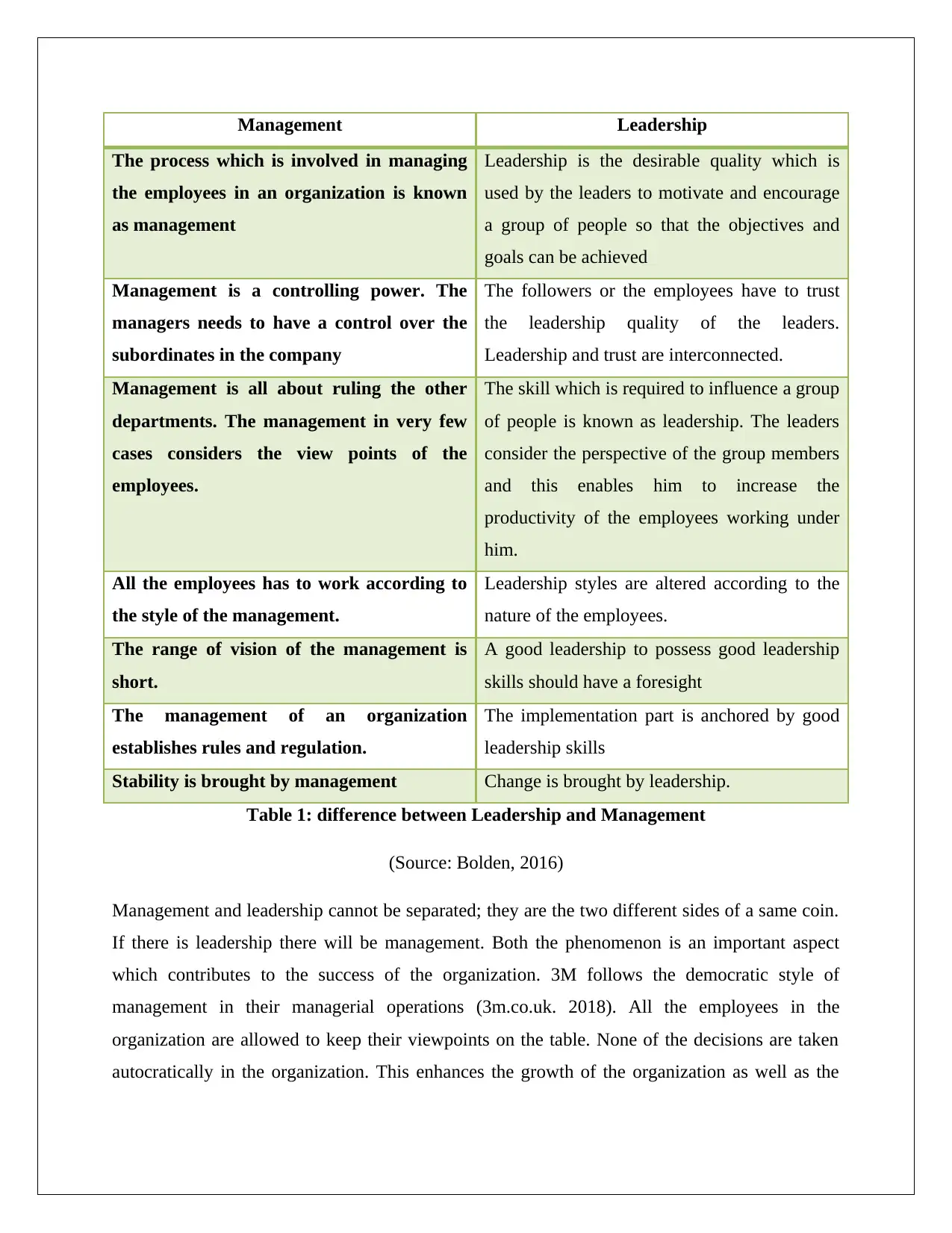
Management Leadership
The process which is involved in managing
the employees in an organization is known
as management
Leadership is the desirable quality which is
used by the leaders to motivate and encourage
a group of people so that the objectives and
goals can be achieved
Management is a controlling power. The
managers needs to have a control over the
subordinates in the company
The followers or the employees have to trust
the leadership quality of the leaders.
Leadership and trust are interconnected.
Management is all about ruling the other
departments. The management in very few
cases considers the view points of the
employees.
The skill which is required to influence a group
of people is known as leadership. The leaders
consider the perspective of the group members
and this enables him to increase the
productivity of the employees working under
him.
All the employees has to work according to
the style of the management.
Leadership styles are altered according to the
nature of the employees.
The range of vision of the management is
short.
A good leadership to possess good leadership
skills should have a foresight
The management of an organization
establishes rules and regulation.
The implementation part is anchored by good
leadership skills
Stability is brought by management Change is brought by leadership.
Table 1: difference between Leadership and Management
(Source: Bolden, 2016)
Management and leadership cannot be separated; they are the two different sides of a same coin.
If there is leadership there will be management. Both the phenomenon is an important aspect
which contributes to the success of the organization. 3M follows the democratic style of
management in their managerial operations (3m.co.uk. 2018). All the employees in the
organization are allowed to keep their viewpoints on the table. None of the decisions are taken
autocratically in the organization. This enhances the growth of the organization as well as the
The process which is involved in managing
the employees in an organization is known
as management
Leadership is the desirable quality which is
used by the leaders to motivate and encourage
a group of people so that the objectives and
goals can be achieved
Management is a controlling power. The
managers needs to have a control over the
subordinates in the company
The followers or the employees have to trust
the leadership quality of the leaders.
Leadership and trust are interconnected.
Management is all about ruling the other
departments. The management in very few
cases considers the view points of the
employees.
The skill which is required to influence a group
of people is known as leadership. The leaders
consider the perspective of the group members
and this enables him to increase the
productivity of the employees working under
him.
All the employees has to work according to
the style of the management.
Leadership styles are altered according to the
nature of the employees.
The range of vision of the management is
short.
A good leadership to possess good leadership
skills should have a foresight
The management of an organization
establishes rules and regulation.
The implementation part is anchored by good
leadership skills
Stability is brought by management Change is brought by leadership.
Table 1: difference between Leadership and Management
(Source: Bolden, 2016)
Management and leadership cannot be separated; they are the two different sides of a same coin.
If there is leadership there will be management. Both the phenomenon is an important aspect
which contributes to the success of the organization. 3M follows the democratic style of
management in their managerial operations (3m.co.uk. 2018). All the employees in the
organization are allowed to keep their viewpoints on the table. None of the decisions are taken
autocratically in the organization. This enhances the growth of the organization as well as the
⊘ This is a preview!⊘
Do you want full access?
Subscribe today to unlock all pages.

Trusted by 1+ million students worldwide
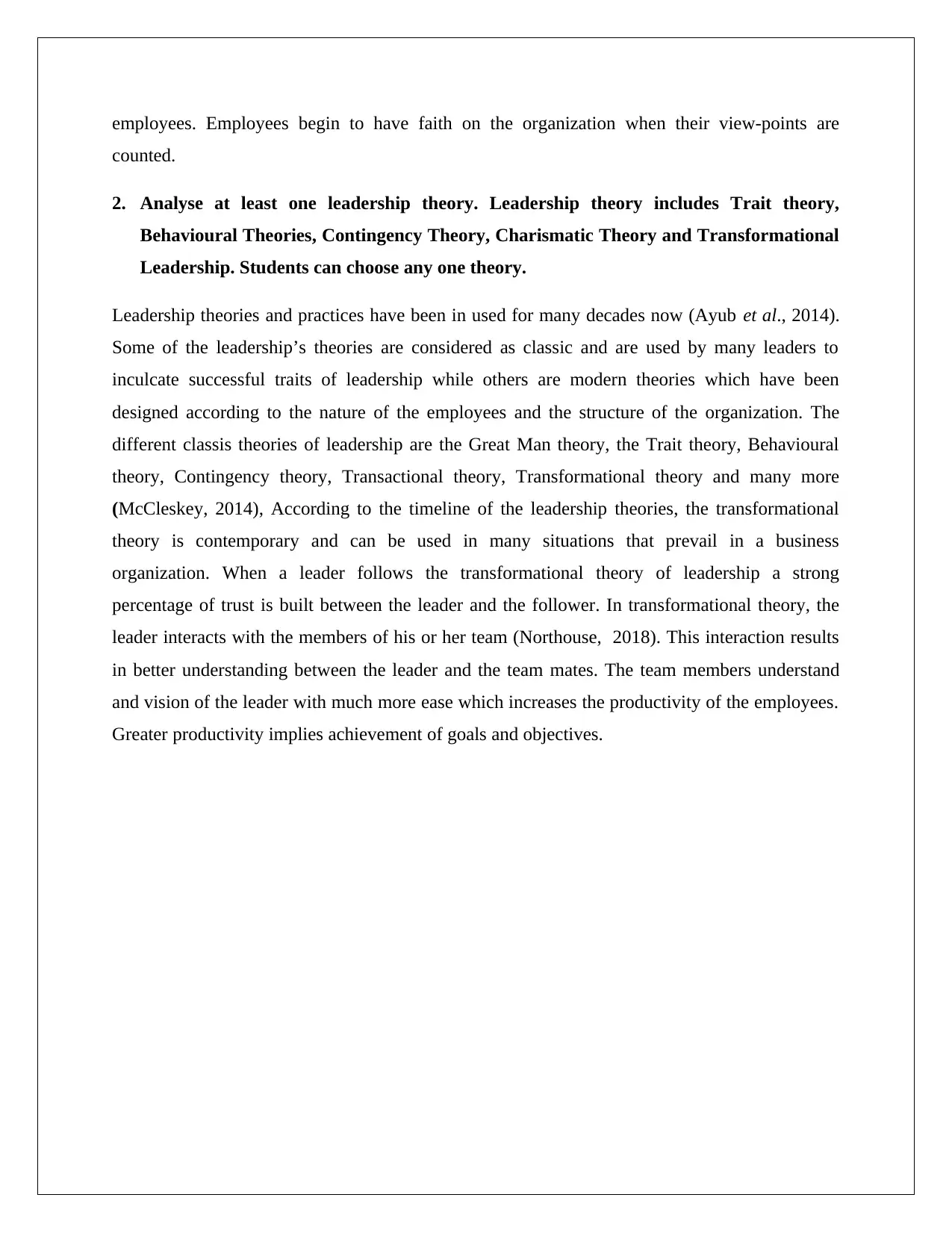
employees. Employees begin to have faith on the organization when their view-points are
counted.
2. Analyse at least one leadership theory. Leadership theory includes Trait theory,
Behavioural Theories, Contingency Theory, Charismatic Theory and Transformational
Leadership. Students can choose any one theory.
Leadership theories and practices have been in used for many decades now (Ayub et al., 2014).
Some of the leadership’s theories are considered as classic and are used by many leaders to
inculcate successful traits of leadership while others are modern theories which have been
designed according to the nature of the employees and the structure of the organization. The
different classis theories of leadership are the Great Man theory, the Trait theory, Behavioural
theory, Contingency theory, Transactional theory, Transformational theory and many more
(McCleskey, 2014), According to the timeline of the leadership theories, the transformational
theory is contemporary and can be used in many situations that prevail in a business
organization. When a leader follows the transformational theory of leadership a strong
percentage of trust is built between the leader and the follower. In transformational theory, the
leader interacts with the members of his or her team (Northouse, 2018). This interaction results
in better understanding between the leader and the team mates. The team members understand
and vision of the leader with much more ease which increases the productivity of the employees.
Greater productivity implies achievement of goals and objectives.
counted.
2. Analyse at least one leadership theory. Leadership theory includes Trait theory,
Behavioural Theories, Contingency Theory, Charismatic Theory and Transformational
Leadership. Students can choose any one theory.
Leadership theories and practices have been in used for many decades now (Ayub et al., 2014).
Some of the leadership’s theories are considered as classic and are used by many leaders to
inculcate successful traits of leadership while others are modern theories which have been
designed according to the nature of the employees and the structure of the organization. The
different classis theories of leadership are the Great Man theory, the Trait theory, Behavioural
theory, Contingency theory, Transactional theory, Transformational theory and many more
(McCleskey, 2014), According to the timeline of the leadership theories, the transformational
theory is contemporary and can be used in many situations that prevail in a business
organization. When a leader follows the transformational theory of leadership a strong
percentage of trust is built between the leader and the follower. In transformational theory, the
leader interacts with the members of his or her team (Northouse, 2018). This interaction results
in better understanding between the leader and the team mates. The team members understand
and vision of the leader with much more ease which increases the productivity of the employees.
Greater productivity implies achievement of goals and objectives.
Paraphrase This Document
Need a fresh take? Get an instant paraphrase of this document with our AI Paraphraser
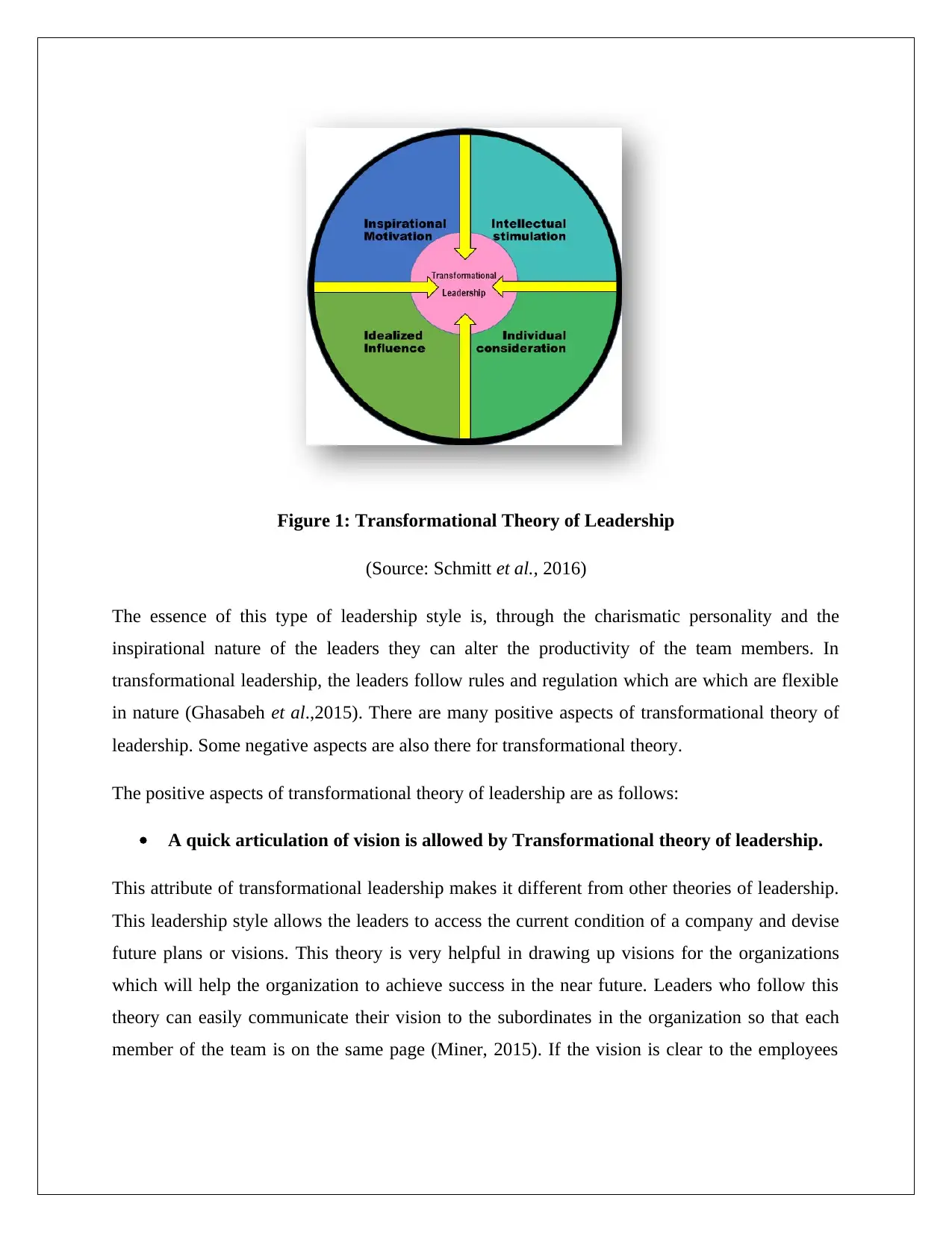
Figure 1: Transformational Theory of Leadership
(Source: Schmitt et al., 2016)
The essence of this type of leadership style is, through the charismatic personality and the
inspirational nature of the leaders they can alter the productivity of the team members. In
transformational leadership, the leaders follow rules and regulation which are which are flexible
in nature (Ghasabeh et al.,2015). There are many positive aspects of transformational theory of
leadership. Some negative aspects are also there for transformational theory.
The positive aspects of transformational theory of leadership are as follows:
A quick articulation of vision is allowed by Transformational theory of leadership.
This attribute of transformational leadership makes it different from other theories of leadership.
This leadership style allows the leaders to access the current condition of a company and devise
future plans or visions. This theory is very helpful in drawing up visions for the organizations
which will help the organization to achieve success in the near future. Leaders who follow this
theory can easily communicate their vision to the subordinates in the organization so that each
member of the team is on the same page (Miner, 2015). If the vision is clear to the employees
(Source: Schmitt et al., 2016)
The essence of this type of leadership style is, through the charismatic personality and the
inspirational nature of the leaders they can alter the productivity of the team members. In
transformational leadership, the leaders follow rules and regulation which are which are flexible
in nature (Ghasabeh et al.,2015). There are many positive aspects of transformational theory of
leadership. Some negative aspects are also there for transformational theory.
The positive aspects of transformational theory of leadership are as follows:
A quick articulation of vision is allowed by Transformational theory of leadership.
This attribute of transformational leadership makes it different from other theories of leadership.
This leadership style allows the leaders to access the current condition of a company and devise
future plans or visions. This theory is very helpful in drawing up visions for the organizations
which will help the organization to achieve success in the near future. Leaders who follow this
theory can easily communicate their vision to the subordinates in the organization so that each
member of the team is on the same page (Miner, 2015). If the vision is clear to the employees
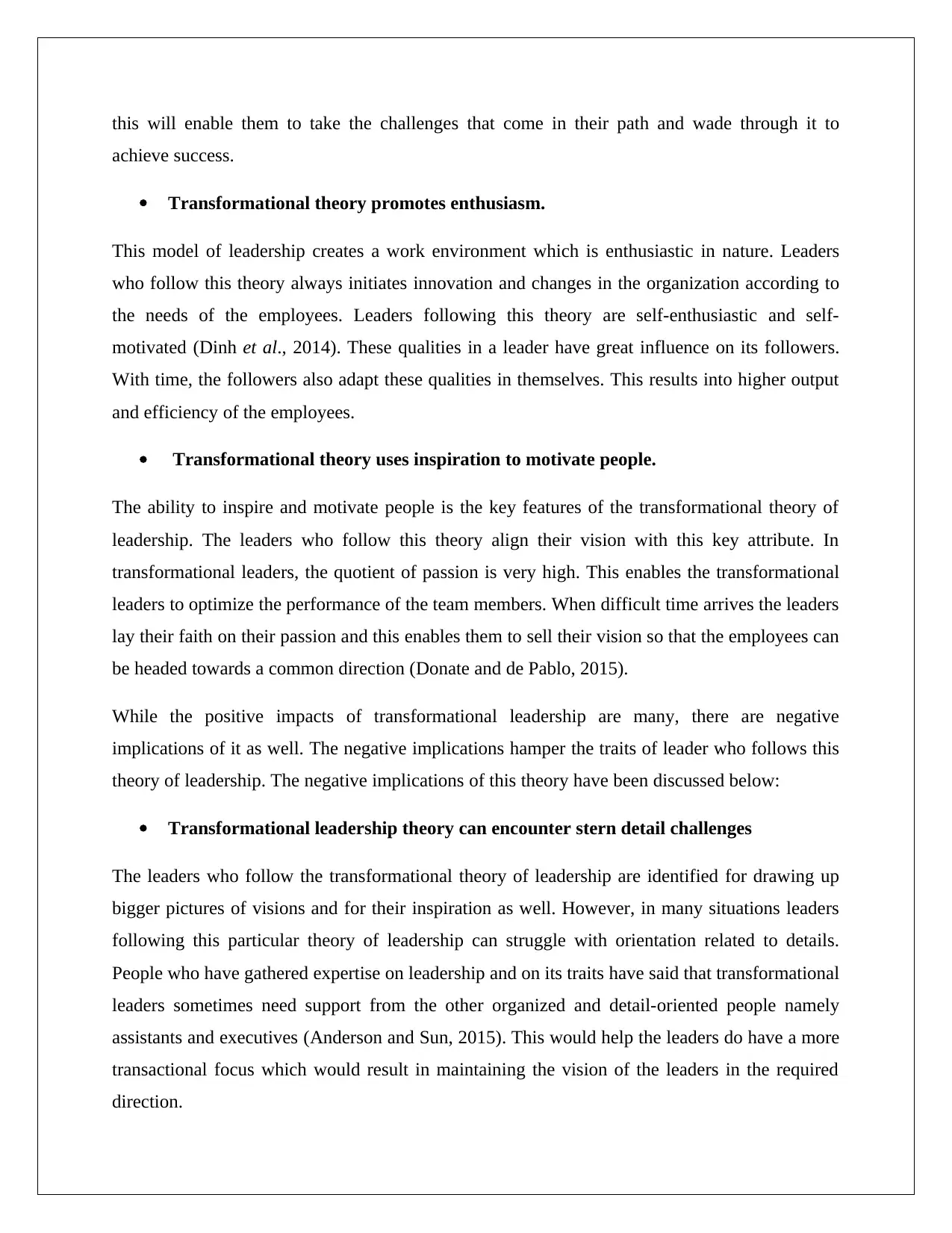
this will enable them to take the challenges that come in their path and wade through it to
achieve success.
Transformational theory promotes enthusiasm.
This model of leadership creates a work environment which is enthusiastic in nature. Leaders
who follow this theory always initiates innovation and changes in the organization according to
the needs of the employees. Leaders following this theory are self-enthusiastic and self-
motivated (Dinh et al., 2014). These qualities in a leader have great influence on its followers.
With time, the followers also adapt these qualities in themselves. This results into higher output
and efficiency of the employees.
Transformational theory uses inspiration to motivate people.
The ability to inspire and motivate people is the key features of the transformational theory of
leadership. The leaders who follow this theory align their vision with this key attribute. In
transformational leaders, the quotient of passion is very high. This enables the transformational
leaders to optimize the performance of the team members. When difficult time arrives the leaders
lay their faith on their passion and this enables them to sell their vision so that the employees can
be headed towards a common direction (Donate and de Pablo, 2015).
While the positive impacts of transformational leadership are many, there are negative
implications of it as well. The negative implications hamper the traits of leader who follows this
theory of leadership. The negative implications of this theory have been discussed below:
Transformational leadership theory can encounter stern detail challenges
The leaders who follow the transformational theory of leadership are identified for drawing up
bigger pictures of visions and for their inspiration as well. However, in many situations leaders
following this particular theory of leadership can struggle with orientation related to details.
People who have gathered expertise on leadership and on its traits have said that transformational
leaders sometimes need support from the other organized and detail-oriented people namely
assistants and executives (Anderson and Sun, 2015). This would help the leaders do have a more
transactional focus which would result in maintaining the vision of the leaders in the required
direction.
achieve success.
Transformational theory promotes enthusiasm.
This model of leadership creates a work environment which is enthusiastic in nature. Leaders
who follow this theory always initiates innovation and changes in the organization according to
the needs of the employees. Leaders following this theory are self-enthusiastic and self-
motivated (Dinh et al., 2014). These qualities in a leader have great influence on its followers.
With time, the followers also adapt these qualities in themselves. This results into higher output
and efficiency of the employees.
Transformational theory uses inspiration to motivate people.
The ability to inspire and motivate people is the key features of the transformational theory of
leadership. The leaders who follow this theory align their vision with this key attribute. In
transformational leaders, the quotient of passion is very high. This enables the transformational
leaders to optimize the performance of the team members. When difficult time arrives the leaders
lay their faith on their passion and this enables them to sell their vision so that the employees can
be headed towards a common direction (Donate and de Pablo, 2015).
While the positive impacts of transformational leadership are many, there are negative
implications of it as well. The negative implications hamper the traits of leader who follows this
theory of leadership. The negative implications of this theory have been discussed below:
Transformational leadership theory can encounter stern detail challenges
The leaders who follow the transformational theory of leadership are identified for drawing up
bigger pictures of visions and for their inspiration as well. However, in many situations leaders
following this particular theory of leadership can struggle with orientation related to details.
People who have gathered expertise on leadership and on its traits have said that transformational
leaders sometimes need support from the other organized and detail-oriented people namely
assistants and executives (Anderson and Sun, 2015). This would help the leaders do have a more
transactional focus which would result in maintaining the vision of the leaders in the required
direction.
⊘ This is a preview!⊘
Do you want full access?
Subscribe today to unlock all pages.

Trusted by 1+ million students worldwide
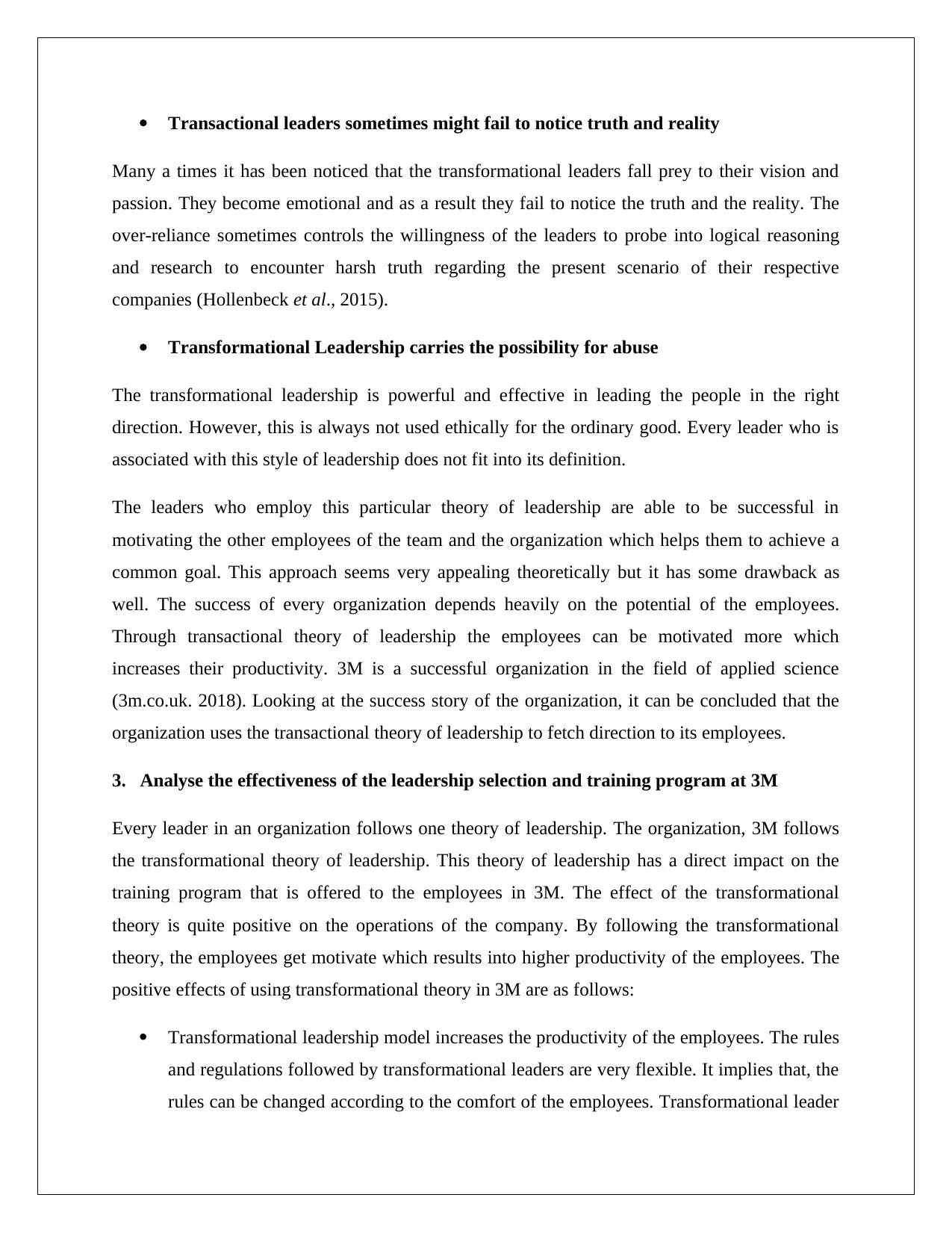
Transactional leaders sometimes might fail to notice truth and reality
Many a times it has been noticed that the transformational leaders fall prey to their vision and
passion. They become emotional and as a result they fail to notice the truth and the reality. The
over-reliance sometimes controls the willingness of the leaders to probe into logical reasoning
and research to encounter harsh truth regarding the present scenario of their respective
companies (Hollenbeck et al., 2015).
Transformational Leadership carries the possibility for abuse
The transformational leadership is powerful and effective in leading the people in the right
direction. However, this is always not used ethically for the ordinary good. Every leader who is
associated with this style of leadership does not fit into its definition.
The leaders who employ this particular theory of leadership are able to be successful in
motivating the other employees of the team and the organization which helps them to achieve a
common goal. This approach seems very appealing theoretically but it has some drawback as
well. The success of every organization depends heavily on the potential of the employees.
Through transactional theory of leadership the employees can be motivated more which
increases their productivity. 3M is a successful organization in the field of applied science
(3m.co.uk. 2018). Looking at the success story of the organization, it can be concluded that the
organization uses the transactional theory of leadership to fetch direction to its employees.
3. Analyse the effectiveness of the leadership selection and training program at 3M
Every leader in an organization follows one theory of leadership. The organization, 3M follows
the transformational theory of leadership. This theory of leadership has a direct impact on the
training program that is offered to the employees in 3M. The effect of the transformational
theory is quite positive on the operations of the company. By following the transformational
theory, the employees get motivate which results into higher productivity of the employees. The
positive effects of using transformational theory in 3M are as follows:
Transformational leadership model increases the productivity of the employees. The rules
and regulations followed by transformational leaders are very flexible. It implies that, the
rules can be changed according to the comfort of the employees. Transformational leader
Many a times it has been noticed that the transformational leaders fall prey to their vision and
passion. They become emotional and as a result they fail to notice the truth and the reality. The
over-reliance sometimes controls the willingness of the leaders to probe into logical reasoning
and research to encounter harsh truth regarding the present scenario of their respective
companies (Hollenbeck et al., 2015).
Transformational Leadership carries the possibility for abuse
The transformational leadership is powerful and effective in leading the people in the right
direction. However, this is always not used ethically for the ordinary good. Every leader who is
associated with this style of leadership does not fit into its definition.
The leaders who employ this particular theory of leadership are able to be successful in
motivating the other employees of the team and the organization which helps them to achieve a
common goal. This approach seems very appealing theoretically but it has some drawback as
well. The success of every organization depends heavily on the potential of the employees.
Through transactional theory of leadership the employees can be motivated more which
increases their productivity. 3M is a successful organization in the field of applied science
(3m.co.uk. 2018). Looking at the success story of the organization, it can be concluded that the
organization uses the transactional theory of leadership to fetch direction to its employees.
3. Analyse the effectiveness of the leadership selection and training program at 3M
Every leader in an organization follows one theory of leadership. The organization, 3M follows
the transformational theory of leadership. This theory of leadership has a direct impact on the
training program that is offered to the employees in 3M. The effect of the transformational
theory is quite positive on the operations of the company. By following the transformational
theory, the employees get motivate which results into higher productivity of the employees. The
positive effects of using transformational theory in 3M are as follows:
Transformational leadership model increases the productivity of the employees. The rules
and regulations followed by transformational leaders are very flexible. It implies that, the
rules can be changed according to the comfort of the employees. Transformational leader
Paraphrase This Document
Need a fresh take? Get an instant paraphrase of this document with our AI Paraphraser
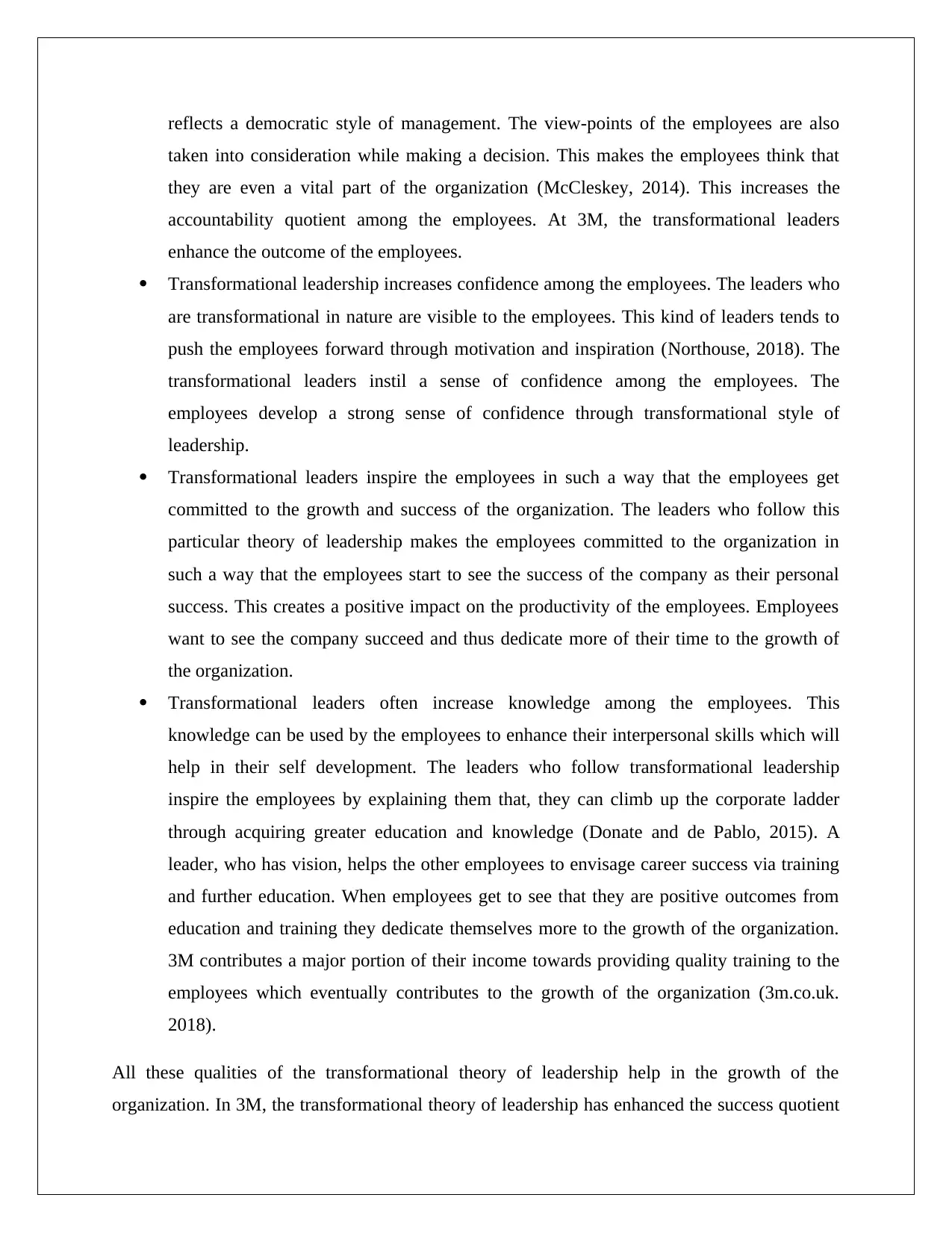
reflects a democratic style of management. The view-points of the employees are also
taken into consideration while making a decision. This makes the employees think that
they are even a vital part of the organization (McCleskey, 2014). This increases the
accountability quotient among the employees. At 3M, the transformational leaders
enhance the outcome of the employees.
Transformational leadership increases confidence among the employees. The leaders who
are transformational in nature are visible to the employees. This kind of leaders tends to
push the employees forward through motivation and inspiration (Northouse, 2018). The
transformational leaders instil a sense of confidence among the employees. The
employees develop a strong sense of confidence through transformational style of
leadership.
Transformational leaders inspire the employees in such a way that the employees get
committed to the growth and success of the organization. The leaders who follow this
particular theory of leadership makes the employees committed to the organization in
such a way that the employees start to see the success of the company as their personal
success. This creates a positive impact on the productivity of the employees. Employees
want to see the company succeed and thus dedicate more of their time to the growth of
the organization.
Transformational leaders often increase knowledge among the employees. This
knowledge can be used by the employees to enhance their interpersonal skills which will
help in their self development. The leaders who follow transformational leadership
inspire the employees by explaining them that, they can climb up the corporate ladder
through acquiring greater education and knowledge (Donate and de Pablo, 2015). A
leader, who has vision, helps the other employees to envisage career success via training
and further education. When employees get to see that they are positive outcomes from
education and training they dedicate themselves more to the growth of the organization.
3M contributes a major portion of their income towards providing quality training to the
employees which eventually contributes to the growth of the organization (3m.co.uk.
2018).
All these qualities of the transformational theory of leadership help in the growth of the
organization. In 3M, the transformational theory of leadership has enhanced the success quotient
taken into consideration while making a decision. This makes the employees think that
they are even a vital part of the organization (McCleskey, 2014). This increases the
accountability quotient among the employees. At 3M, the transformational leaders
enhance the outcome of the employees.
Transformational leadership increases confidence among the employees. The leaders who
are transformational in nature are visible to the employees. This kind of leaders tends to
push the employees forward through motivation and inspiration (Northouse, 2018). The
transformational leaders instil a sense of confidence among the employees. The
employees develop a strong sense of confidence through transformational style of
leadership.
Transformational leaders inspire the employees in such a way that the employees get
committed to the growth and success of the organization. The leaders who follow this
particular theory of leadership makes the employees committed to the organization in
such a way that the employees start to see the success of the company as their personal
success. This creates a positive impact on the productivity of the employees. Employees
want to see the company succeed and thus dedicate more of their time to the growth of
the organization.
Transformational leaders often increase knowledge among the employees. This
knowledge can be used by the employees to enhance their interpersonal skills which will
help in their self development. The leaders who follow transformational leadership
inspire the employees by explaining them that, they can climb up the corporate ladder
through acquiring greater education and knowledge (Donate and de Pablo, 2015). A
leader, who has vision, helps the other employees to envisage career success via training
and further education. When employees get to see that they are positive outcomes from
education and training they dedicate themselves more to the growth of the organization.
3M contributes a major portion of their income towards providing quality training to the
employees which eventually contributes to the growth of the organization (3m.co.uk.
2018).
All these qualities of the transformational theory of leadership help in the growth of the
organization. In 3M, the transformational theory of leadership has enhanced the success quotient
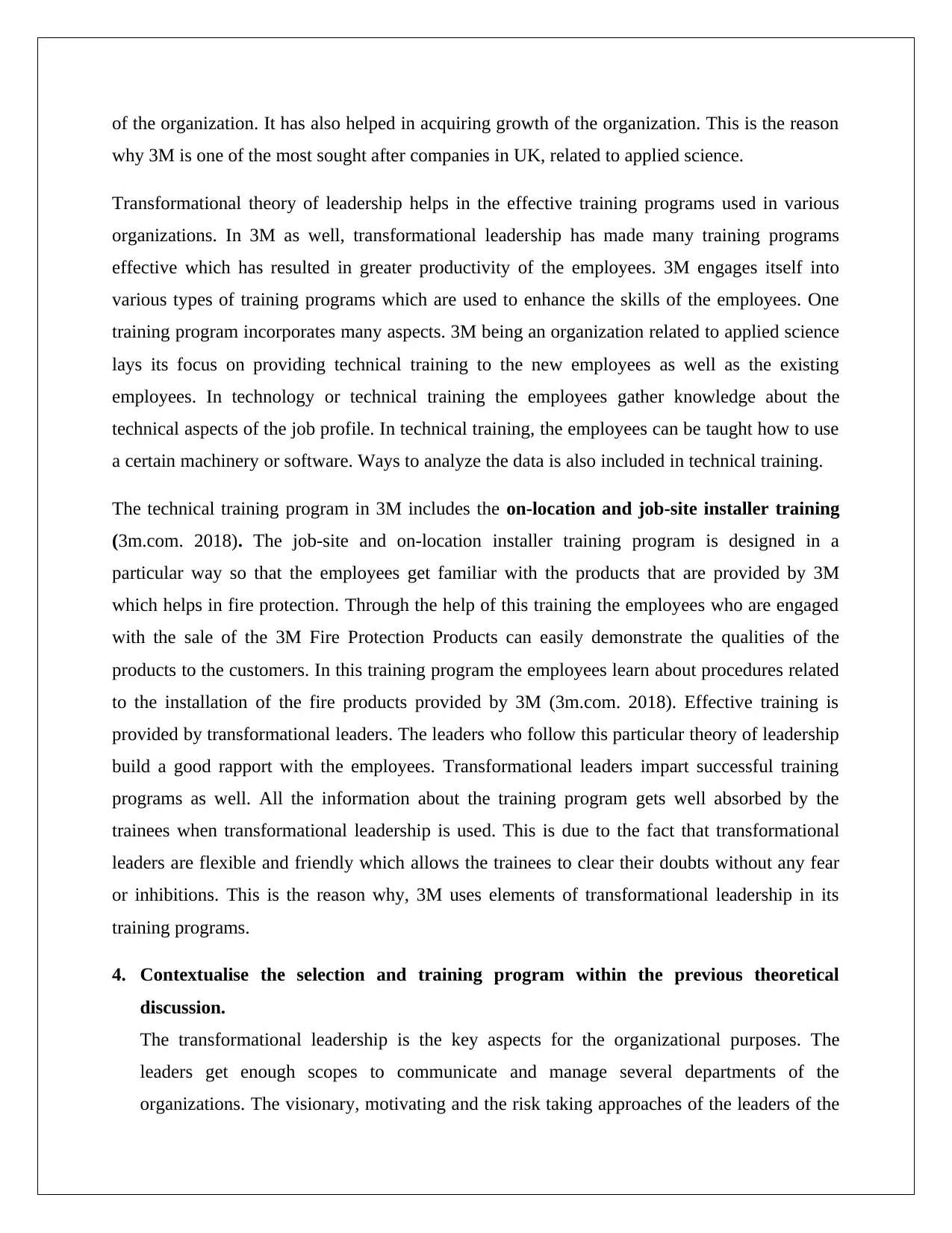
of the organization. It has also helped in acquiring growth of the organization. This is the reason
why 3M is one of the most sought after companies in UK, related to applied science.
Transformational theory of leadership helps in the effective training programs used in various
organizations. In 3M as well, transformational leadership has made many training programs
effective which has resulted in greater productivity of the employees. 3M engages itself into
various types of training programs which are used to enhance the skills of the employees. One
training program incorporates many aspects. 3M being an organization related to applied science
lays its focus on providing technical training to the new employees as well as the existing
employees. In technology or technical training the employees gather knowledge about the
technical aspects of the job profile. In technical training, the employees can be taught how to use
a certain machinery or software. Ways to analyze the data is also included in technical training.
The technical training program in 3M includes the on-location and job-site installer training
(3m.com. 2018). The job-site and on-location installer training program is designed in a
particular way so that the employees get familiar with the products that are provided by 3M
which helps in fire protection. Through the help of this training the employees who are engaged
with the sale of the 3M Fire Protection Products can easily demonstrate the qualities of the
products to the customers. In this training program the employees learn about procedures related
to the installation of the fire products provided by 3M (3m.com. 2018). Effective training is
provided by transformational leaders. The leaders who follow this particular theory of leadership
build a good rapport with the employees. Transformational leaders impart successful training
programs as well. All the information about the training program gets well absorbed by the
trainees when transformational leadership is used. This is due to the fact that transformational
leaders are flexible and friendly which allows the trainees to clear their doubts without any fear
or inhibitions. This is the reason why, 3M uses elements of transformational leadership in its
training programs.
4. Contextualise the selection and training program within the previous theoretical
discussion.
The transformational leadership is the key aspects for the organizational purposes. The
leaders get enough scopes to communicate and manage several departments of the
organizations. The visionary, motivating and the risk taking approaches of the leaders of the
why 3M is one of the most sought after companies in UK, related to applied science.
Transformational theory of leadership helps in the effective training programs used in various
organizations. In 3M as well, transformational leadership has made many training programs
effective which has resulted in greater productivity of the employees. 3M engages itself into
various types of training programs which are used to enhance the skills of the employees. One
training program incorporates many aspects. 3M being an organization related to applied science
lays its focus on providing technical training to the new employees as well as the existing
employees. In technology or technical training the employees gather knowledge about the
technical aspects of the job profile. In technical training, the employees can be taught how to use
a certain machinery or software. Ways to analyze the data is also included in technical training.
The technical training program in 3M includes the on-location and job-site installer training
(3m.com. 2018). The job-site and on-location installer training program is designed in a
particular way so that the employees get familiar with the products that are provided by 3M
which helps in fire protection. Through the help of this training the employees who are engaged
with the sale of the 3M Fire Protection Products can easily demonstrate the qualities of the
products to the customers. In this training program the employees learn about procedures related
to the installation of the fire products provided by 3M (3m.com. 2018). Effective training is
provided by transformational leaders. The leaders who follow this particular theory of leadership
build a good rapport with the employees. Transformational leaders impart successful training
programs as well. All the information about the training program gets well absorbed by the
trainees when transformational leadership is used. This is due to the fact that transformational
leaders are flexible and friendly which allows the trainees to clear their doubts without any fear
or inhibitions. This is the reason why, 3M uses elements of transformational leadership in its
training programs.
4. Contextualise the selection and training program within the previous theoretical
discussion.
The transformational leadership is the key aspects for the organizational purposes. The
leaders get enough scopes to communicate and manage several departments of the
organizations. The visionary, motivating and the risk taking approaches of the leaders of the
⊘ This is a preview!⊘
Do you want full access?
Subscribe today to unlock all pages.

Trusted by 1+ million students worldwide
1 out of 18
Related Documents
Your All-in-One AI-Powered Toolkit for Academic Success.
+13062052269
info@desklib.com
Available 24*7 on WhatsApp / Email
![[object Object]](/_next/static/media/star-bottom.7253800d.svg)
Unlock your academic potential
Copyright © 2020–2025 A2Z Services. All Rights Reserved. Developed and managed by ZUCOL.




